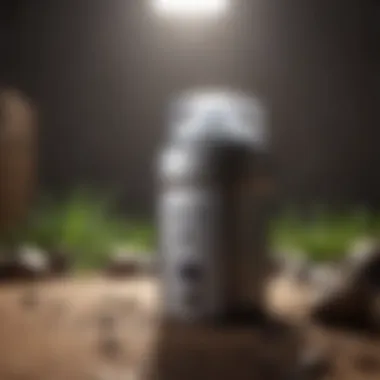CFL Disposal: Safe and Responsible Practices


Overview of the Topic
Compact Fluorescent Lamps (CFLs) have become widely used due to their energy efficiency compared to traditional incandescent bulbs. However, while they offer environmental benefits in terms of reduced energy consumption, the disposal of CFLs raises significant concerns. This is primarily due to the presence of mercury within the bulbs, which can pose substantial risks if not handled properly.
Background information on the significance of the topic
The significance of proper CFL disposal cannot be overstated. When disposed of in regular household trash, CFLs can break, leading to a release of toxic mercury into the environment. This poses not just a risk to local ecosystems but also to human health, as mercury can contaminate soil and water supplies. Therefore, raising awareness about safe disposal methods is crucial for ensuring responsible environmental stewardship.
Current Status and Challenges
Examination of the current state of the natural resource or environmental concern
Regulations surrounding CFL disposal vary by state and country. In many places, CFLs are classified as hazardous waste due to their mercury content. Yet, many individuals remain unaware of these regulations, leading to improper disposal practices.
Identification of challenges and threats facing the topic
One major challenge is the lack of accessible recycling options. While there are programs in place, they are not always well-publicized or available in all regions. Furthermore, misinformation about CFL safety can deter people from recycling them altogether. This lack of clarity contributes to ongoing environmental risks.
Sustainable Solutions
Exploration of sustainable practices and solutions to address the issues highlighted
Adopting sustainable practices involves educating the public about available recycling facilities. Stores like Home Depot and Lowe's often have recycling drop-off programs, making it easier for consumers to dispose of their CFLs responsibly. Local municipal waste management departments may also have designated disposal days or locations, and it's advisable to check with them for more information.
Showcase of successful case studies or examples of effective resource management
Some communities have implemented successful outreach programs to increase awareness of CFL disposal. For example, a city-wide initiative in San Francisco aimed at educating residents about proper disposal methods resulted in a marked decrease in improperly discarded bulbs. This highlights the essential role of public education in fostering responsible behavior regarding hazardous waste.
Impact and Importance
Analysis of the impact of the topic on ecosystems, communities, and future generations
The impact of improper CFL disposal extends far beyond immediate hazards. Contaminated water and soil can affect local wildlife and plant life, disrupting entire ecosystems. Over time, high levels of mercury exposure can lead to severe health issues for entire communities, particularly vulnerable populations such as children and the elderly.
Emphasis on the importance of conservation efforts and sustainable resource use
A commitment to responsible CFL disposal reflects broader conservation efforts, underscoring the need for individuals and businesses alike to adhere to environmental standards. Awareness and action in this regard can lead to a healthier planet for current and future generations.
Understanding CFLs and Their Composition
Understanding compact fluorescent lamps (CFLs) is essential for recognizing their impact and the necessary measures needed to dispose of them properly. This section will delve into what CFLs are, the materials they consist of, and their advantages. By grasping these elements, individuals can appreciate the significance of responsible CFL disposal practices and the potential hazards associated with improper disposal.
What are Compact Fluorescent Lamps?
Compact fluorescent lamps, or CFLs, are a type of energy-efficient lighting technology. Unlike traditional incandescent bulbs, CFLs use a fraction of the energy to produce the same amount of light. They have a longer lifespan, which makes them popular among consumers looking to reduce their electricity bills. CFLs create light by passing an electric current through a tube filled with a gas, which emits ultraviolet light. This light then excites a phosphor coating inside the lamp, producing visible light. The compact design allows them to fit into standard light sockets, making it easy to replace older bulbs.
Materials Used in CFLs
CFLs are made from various materials that contribute to their function and effectiveness.
Glass
The primary material used in CFLs is glass. It serves as a protective enclosure for the internal components. The glass used is typically thin, lightweight, and designed to withstand heat. Its crucial characteristic is that it allows light to pass through while containing the gases and phosphors within. This is beneficial as it helps to maintain the integrity of the bulb under operating conditions. However, glass can break easily if dropped, leading to potential safety hazards if not handled properly.
Phosphor coatings
Phosphor coatings play a significant role in the operation of CFLs. These coatings are essential for converting ultraviolet light into visible light. The key characteristic of phosphor coatings is their ability to create a spectrum of light that can mimic natural daylight. This feature makes CFLs aesthetically pleasing to many users. However, not all phosphor coatings are the same; some may degrade over time, affecting brightness and efficiency, which is a disadvantage to consider when choosing CFLs.


Mercury content
CFLs contain a small amount of mercury, a hazardous element crucial for their functionality. The mercury vapor inside the bulb is what allows it to produce light efficiently. The presence of mercury is a significant concern because it poses health risks if the bulb breaks and releases mercury into the environment. This unique feature of CFLs makes their proper disposal crucial. While the mercury content is minimal and typically safely contained, improper disposal can lead to environmental contamination. Therefore, awareness about safe disposal alternatives is necessary.
Benefits of Using CFLs
Using CFLs presents numerous benefits. Firstly, they are energy-efficient, consuming about 75% less energy compared to incandescent bulbs. This leads to reduced electricity costs and a decreased carbon footprint. Furthermore, CFLs have a longer lifespan, often lasting up to ten times longer than traditional bulbs, which means fewer replacements and reduced waste. Their design encourages the responsible use of energy resources, aligning with sustainability goals. Overall, the use of CFLs represents a step towards more energy-aware lifestyles and conservation efforts.
Environmental Impact of Improper Disposal
Understanding the environmental impact of improper disposal of compact fluorescent lamps (CFLs) is crucial for several reasons. CFLs contain mercury and other substances that can pose serious threats to both human health and the ecosystem if disposed of incorrectly. Improper disposal leads to the release of these hazardous materials into the environment, creating long-lasting problems. This section aims to shine a light on the dangers stemming from improper CFL disposal and increase awareness of the necessary precautions that can be taken.
Hazards of Mercury Release
Health risks
The health risks associated with the release of mercury from CFLs are significant. Mercury is a neurotoxin, and its exposure can lead to severe health problems, including cognitive impairments and neurological disorders. When CFLs break, they release mercury vapor. This vapor can be inhaled or absorbed through the skin, and it is especially dangerous for pregnant women, infants, and young children. This particular aspect makes the safe disposal of CFLs more than just a recommendation; it becomes a societal imperative.
The key characteristic of these health risks is not just the direct toxicity of mercury, but also the cumulative effects over time. Many people may not be aware of how hazardous this situation is, making them less cautious. It is a priority in this article to raise awareness about these risks, emphasizing that managing CFL disposal properly is essential for protecting public health.
Ecological consequences
The ecological consequences of improper CFL disposal are profound and far-reaching. When mercury leaches into the soil or water systems, it can bioaccumulate in fish and other wildlife. This buildup can disturb entire food chains and cause detrimental effects on biodiversity. Furthermore, mercury pollution often leads to advisories against fish consumption in affected areas, impacting recreational fishing and the local economy.
The importance of highlighting ecological consequences lies in the increasing public concern for environmental preservation. Understanding that improper disposal can lead to broader ecological issues supports the overarching goal of responsible CFL management. Failure to address these consequences ultimately results in a less sustainable future, impacting generations to come.
Impact on Landfills
Long-term sustainability issues
Landfills are intended for waste that cannot be recycled or reused, yet the presence of CFLs raises long-term sustainability concerns. When CFLs are tossed into landfills, they break down over time, releasing dangerous chemicals into the atmosphere and surrounding soil. This process can lead to groundwater contamination and air pollution, affecting plant and animal life. The continuous accumulation of such waste in landfills challenges the sustainability of waste management systems and resources.
The unique feature of these sustainability issues is the necessity for more responsible consumption and disposal practices. Highlighting these challenges in this article supports an understanding of the need for an ecosystem that prioritizes waste reduction, recycling, and responsible disposal.
Landfill regulations
Landfill regulations play an essential role in governing the disposal of hazardous materials like CFLs. Different states have varying regulations, which can lead to confusion among consumers. Some areas have strict bans on disposing hazardous waste in regular landfills, while others may have more lenient rules. It is critical to take these regulations seriously, as non-compliance can result in severe penalties and environmental degradation.
This aspect of landfill regulations serves as a reminder that consumers must educate themselves on their local laws regarding CFL disposal. By understanding these regulations, they not only comply with the law but also contribute to a cleaner environment. The unique element here is that these regulations vary, making it vital for individuals to be proactive in understanding what is required in their area. Educating the public about these regulations can help enhance adherence and improve overall waste management practices.
CFL Disposal Regulations and Policies
CFL disposal regulations and policies are critical in ensuring that the widespread use of Compact Fluorescent Lamps does not pose a threat to human health or the environment. These regulations provide a framework that guides individuals and businesses on the proper disposal of CFLs, which are known to contain hazardous materials, including mercury. While many people enjoy the energy efficiency of CFLs, it is vital to understand the implications of disposing of them incorrectly. \
The presence of mercury in these lamps makes regulatory measures important. The risk of mercury release, whether through breakage or improper disposal, can lead to severe environmental degradation and health issues. Therefore, regulations and policies are designed not only to mitigate these risks but also to promote responsible practices.
State Regulations on CFL Disposal
Different states have put in place various regulations regarding the disposal of CFLs. This local legislation often reflects the unique environmental concerns and waste management systems of each region. For instance, some states may require special labeling for CFLs or mandate that retailers offer recycling services. Others might impose fines for improper disposal.
Understanding local regulations is essential. Consumers should be aware of resources such as state environmental websites that inform on specific disposal requirements. Not knowing these regulations can lead to inadvertent violations and environmental damage.
National Guidelines for Hazardous Waste
National guidelines provide overarching standards and practices that states can adopt or enforce. These guidelines help standardize the way hazardous materials, including CFLs, are dealt with across the country. Two notable regulatory frameworks in this context are the EPA regulations and the Resource Conservation and Recovery Act.
EPA Regulations
The Environmental Protection Agency (EPA) has established regulations that govern the disposal of hazardous waste, including CFLs. One of the key aspects of EPA regulations is the focus on safe handling and disposal practices that prevent pollution and protect public health. These regulations outline requirements for waste collection, transportation, and treatment. \


A distinguishing characteristic of EPA regulations is their emphasis on reducing hazardous waste generation through regulations and educational campaigns. This approach is particularly beneficial to our guide as it aligns with the overall goal of promoting responsible CFL disposal.
However, while the EPA regulations do provide a clear guideline, the challenges often lie in their implementation. Many users may not be aware of these regulations, ultimately leading to improper disposal.
Resource Conservation and Recovery Act
The Resource Conservation and Recovery Act (RCRA) serves as a fundamental piece of legislation regarding hazardous waste management. This act focuses on waste management practices that protect human health and the environment. RCRA’s key feature is its cradle-to-grave concept, ensuring that hazardous waste is tracked from its origin to its final disposal. \
For our article, highlighting RCRA is beneficial as it mandates careful tracking and management of hazardous waste. This regulation supports initiatives to recycle CFLs and prevent them from ending up in landfills where they can cause contamination. Its unique feature is the comprehensive approach to waste management, ensuring all stakeholders are involved in the process. However, the potential downside lies in the administrative compliance that may be burdensome for smaller businesses.
By exploring both state regulations and national guidelines, individuals become more informed about their responsibilities when disposing of CFLs. Understanding these frameworks fosters better decision-making and ultimately reduces the environmental impact associated with improper lamp disposal.
Proper CFL disposal protects our health and stewards the environment. Please take the regulations seriously.
Best Practices for CFL Disposal
Effectively managing the disposal of Compact Fluorescent Lamps (CFLs) is paramount for environmental safety and public health. Understanding best practices in CFL disposal not only helps mitigate harmful effects on the ecosystem but also contributes to community well-being. As such, adhering to proper disposal methods is essential for responsible consumer behavior and environmental stewardship.
Recycling Options for CFLs
Recycling is a key component of responsible CFL disposal. CFLs contain materials that can be reused, reducing the necessity for new raw materials. There are specific recycling centers equipped to handle these lamps safely and responsibly. Many municipalities and environmental organizations offer collection programs that promote recycling options for CFLs.
Benefits of CFL recycling include:
- Recovery of valuable materials like glass and phosphor.
- Prevention of hazardous materials from entering landfills.
- Encouragement of sustainable usage of resources.
Recycling options vary by location, so it is important to check local regulations and available facilities. Some communities might take part in special recycling days, where individuals can drop off their used CFLs at designated spots.
Drop-Off Locations
Many local governments partner with waste management organizations to create drop-off points specifically for hazardous waste such as CFLs. These locations are crucial for safe disposal and often include facilities like transfer stations or hazardous waste collection sites. By utilizing these drop-off locations, individuals contribute to a reduced risk of mercury release and other potential hazards associated with improper disposal.
To find nearby drop-off locations, residents can consult their local waste management department’s website.
It’s advisable to call ahead and confirm what specific items are accepted at these sites.
Key considerations include:
- Ensuring the CFLs are intact when dropping them off.
- Following all local guidelines related to drop-off hours and procedures.
- Being aware that some locations might have restrictions on the number of bulbs an individual can drop off.
Mail-In Recycling Programs
Mail-in recycling programs offer a convenient option for those who may not have access to local recycling centers. Various organizations and companies facilitate mail-in recycling for CFLs, ensuring safe processing of these hazardous materials. Customers can purchase a prepaid recycling kit that often includes special packaging designed to safely transport the bulbs to proper recycling facilities.
Advantages of mail-in recycling programs comprise:
- Flexibility for participants, allowing them to recycle at their convenience.
- Increased visibility of recycling efforts as activities can often be tracked online.
- Reduced risks of breaking bulbs during transport, as materials are specifically designed for safety.
Individuals interested in this option should research companies offering these services. This ensures compliance with any shipping guidelines and helps in choosing a reputable organization committed to environmental protection.
Consumer Responsibilities and Awareness
Understanding consumer responsibilities is essential in ensuring safe and ethical CFL disposal. The decisions made by individuals have a powerful impact on the environment. Awareness of how to manage CFLs helps in minimizing their negative effects on health and ecosystems. Each consumer carries the burden of guidance and action; their participation is crucial.
Educating the Community
Educating the community about CFL disposal is not just about sharing facts. It is about fostering a culture of responsibility and action. Community events, workshops, and social media campaigns can help disseminate information. By engaging local leaders and influencers, awareness can expand rapidly. When individuals understand the implications of improper CFL disposal, they are more likely to act responsibly. Leveraging local forums or social media platforms like Reddit and Facebook allows for collaborative discussions, enhancing public knowledge.
Safe Handling of Broken CFLs


Handling broken CFLs correctly is vital for health and safety.
Immediate actions
When a CFL breaks, immediate action is paramount. The first step is to leave the room for a minimum of 15 minutes. This reduces exposure to mercury vapors that may be released. Open windows to ventilate the space and allow fresh air to flow in. This initial action shows a responsibility to minimize risk. It protects not only oneself but also others in the vicinity.
An advantage of these immediate actions is the focus on vapor reduction. Avoiding unnecessary exposure aids in personal safety, making it a sensible step.
Cleaning guidelines
After the room has been aired out, the next step involves cleaning up safely. Wearing gloves is essential to prevent direct contact with sharp glass and any potential mercury. Use a damp paper towel, not a vacuum cleaner, to gather the broken pieces. This method captures small fragments and avoids spreading possible contamination.
These cleaning guidelines emphasize the importance of a cautious approach. They empower individuals to take practical steps in managing hazard safely and responsibly. Following these guidelines minimizes risk and assists in proper handling of hazardous materials.
"Proper handling and disposal are not just responsibilities but critical actions we can take for the health of our communities."
By prioritizing education and awareness, we encourage proactive measures that address the environmental challenges associated with CFLs. Engaging in responsible behaviors fosters a culture of sustainability that benefits both society and the planet.
Innovations in CFL Disposal and Recycling
The topic of innovations in CFL disposal and recycling is vital for enhancing our environmental practices. CFLs contain mercury, which can threaten the environment if disposed of improperly. Thus, finding innovative and safer methods for disposal and recycling becomes essential. Advancements in technology not only help in reducing the ecological footprint but also promote sustainable practices among consumers and industries alike. The focus on recycling ensures that valuable materials are not lost, and the impact of hazardous waste is mitigated.
Advances in Recycling Technology
Recent breakthroughs in recycling technology have significantly improved the efficiency and safety of CFL disposal. Companies are now utilizing specialized equipment that captures mercury vapor and recycles glass components. This technology reduces the risk associated with mercury exposure during processing. Moreover, advancements in collection systems have streamlined the process of gathering used CFLs from consumers, making it easier for people to participate in safe disposal practices.
The implementation of these advanced solutions not only eases the burden of disposal but also promotes awareness about responsible consumption and disposal methods. As recycling technologies evolve, we can anticipate even higher recovery rates of materials, ensuring that fewer resources are wasted.
Emerging Alternatives to CFLs
The mention of alternatives to CFLs is increasingly relevant as awareness of environmental issues rises. Notably, LED technology has emerged as a significant player in this transition.
LED technology
LED bulbs stand out for their energy efficiency and long lifespan compared to CFLs. They consume less power, which translates to reduced electricity bills for consumers. The unique feature of LEDs is their ability to provide instant light without a warm-up period, which is often required by CFLs. Additionally, LED bulbs do not contain hazardous materials like mercury, making them a safer option for consumers concerned about environmental impacts.
Though initially more expensive, the longevity and efficiency of LED bulbs make them a cost-effective choice over time. Many consumers and businesses are making the shift toward LEDs, prompted by the increasing availability and affordability of these products in the market.
Energy efficiency comparisons
A critical aspect of energy efficiency comparisons is assessing the performance of CFLs against LEDs. In direct comparisons, LEDs typically use between 75% to 80% less energy than traditional incandescent bulbs and offer a longer lifespan. Moreover, LEDs last up to 25,000 hours, while CFLs average around 10,000 hours. This superior efficiency is a straightforward advantage of LEDs, encouraging further adoption among consumers.
However, one consideration is the upfront cost of LED technology, which might deter some consumers. Despite this initial investment, the long-term savings in electricity and replacement costs generally outweigh the initial price—making LEDs not just a glowing choice but an economically wise decision as well.
In summary, innovations in CFL disposal and recycling play a crucial role in protecting the environment while also promoting new, safer lighting technologies. These developments urge us to think critically about our choices and the implications they may have on the planet.
Closure: A Call to Action on CFL Disposal
The responsible disposal of Compact Fluorescent Lamps (CFLs) extends beyond the act itself and taps into broader themes of environmental stewardship and public health. As the usage of CFLs has become prevalent due to their energy efficiency, understanding the implications of their disposal is crucial. The risks associated with improper disposal, particularly regarding mercury contamination, cannot be overstated. Therefore, raising awareness around responsible CFL disposal practices is an urgent necessity.
The Role of Individual Action
Individual actions play a significant role in addressing the challenges of CFL disposal. When consumers educate themselves about how to dispose of CFLs properly, they not only protect their immediate environment but also influence those around them. Simple steps, like recycling CFLs instead of throwing them in the regular trash, demonstrate a commitment to sustainability. By seeking out recycling programs or local drop-off centers, individuals can ensure that toxic materials are managed correctly.
Moreover, sharing knowledge about CFL disposal in community settings can lead to collective change. Schools, local organizations, and online forums can serve as platforms to promote responsible behavior regarding CFLs. Individuals turning awareness into action can spark a ripple effect, inspiring others to join the cause. This grassroots involvement is vital to building a culture of accountability towards hazardous waste management.
Collective Responsibility for the Environment
The notion of collective responsibility further amplifies the impacts of individual actions. It emphasizes the shared obligation of all stakeholders—government bodies, businesses, and consumers—in managing CFL waste effectively. Local governments can implement policies to streamline recycling processes, making it easier for citizens to comply with safe disposal practices. Businesses can take initiative by ensuring compliance with environmental standards and promoting sustainable practices within their operations.
The integration of community efforts is essential. Public awareness campaigns can inform citizens about local disposal methods and the risks of improper disposal. Engaging schools and local organizations is a way to foster a community spirit of environmental responsibility. By collaborating, the community can create a more significant push towards reducing the ecological footprint.
"Individual actions combined with collective responsibility create the foundation for effective environmental stewardship."
Emphasizing these principles will enhance the effectiveness of CFL disposal strategies, ultimately leading to a healthier planet.



